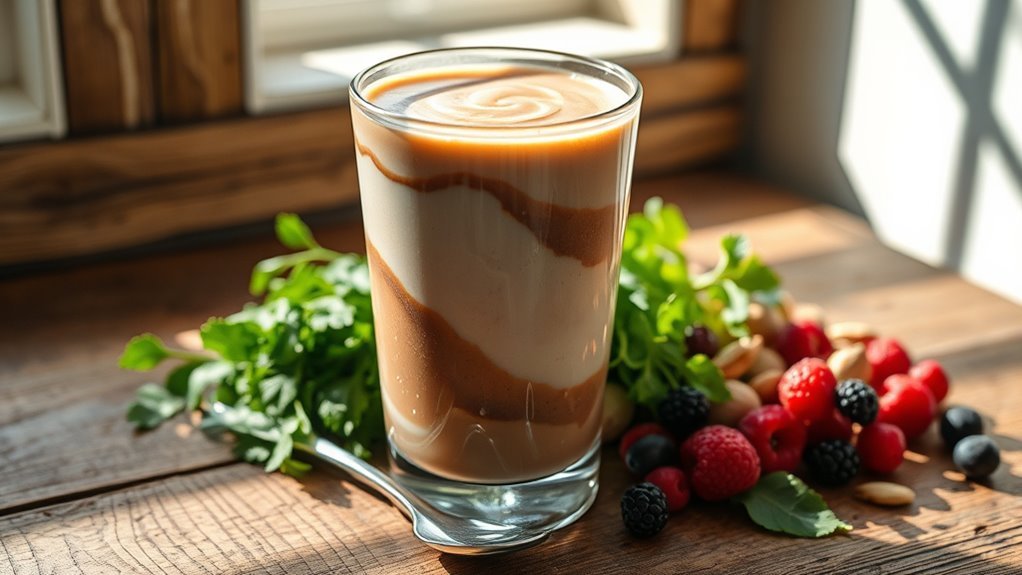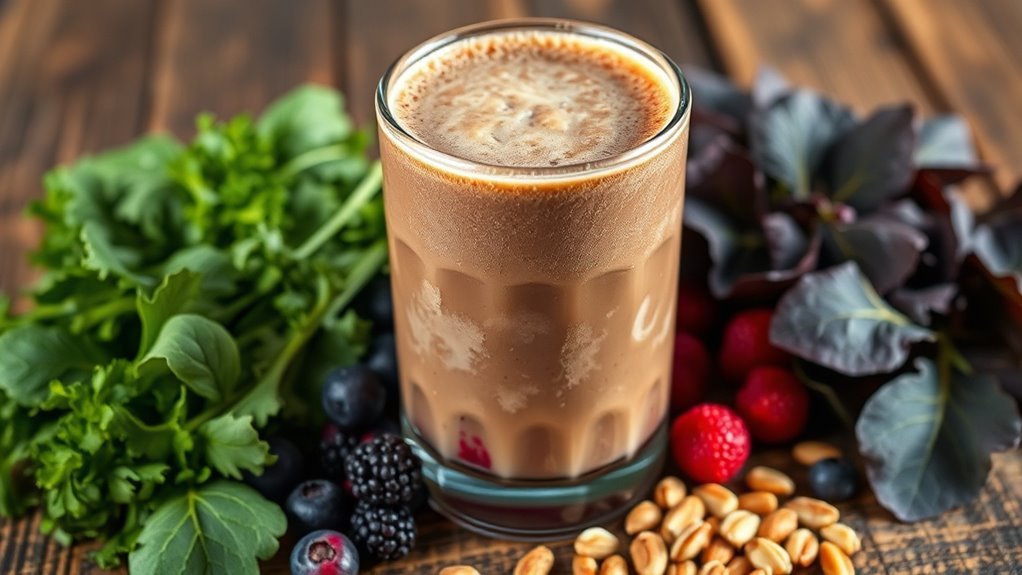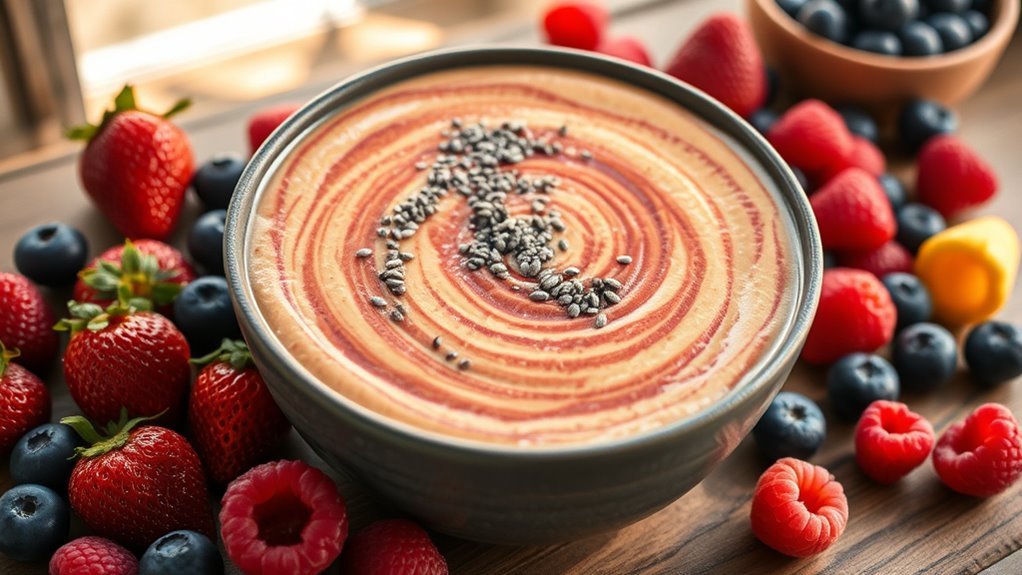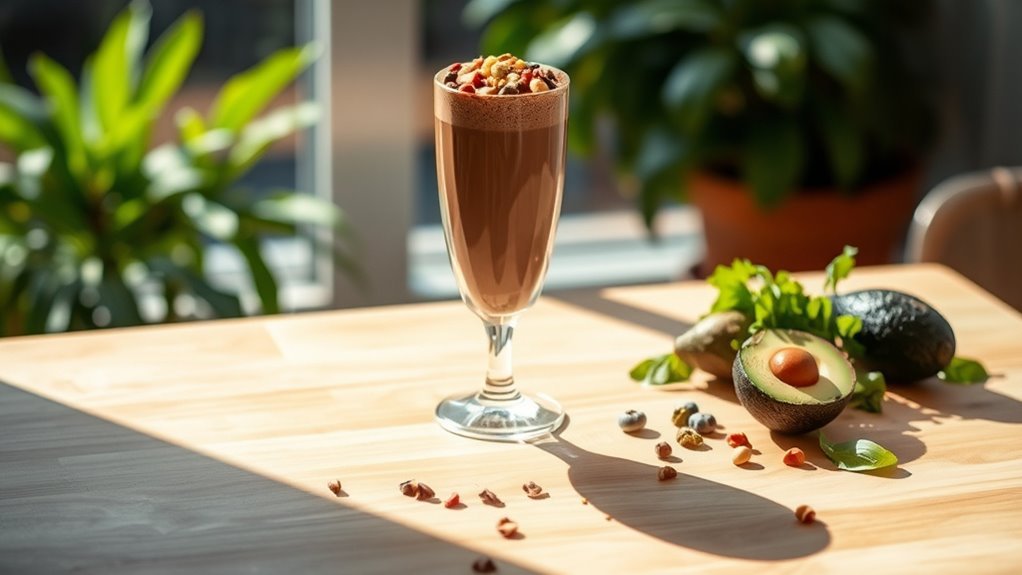Ka’chava can fit into a ketogenic diet, but the carbohydrate content requires careful monitoring. Each serving contains about 24-25 grams of carbs, which translates to around 14-15 grams of net carbs. While it’s rich in protein and fiber, which can help with satiety, the higher carb levels might affect your ability to maintain ketosis. If you’re looking for ways to incorporate Ka’chava into your keto plan or exploring alternatives, there’s much more to take into account.
What Is Ka’chava?

Ka’chava is a nutrient-dense meal replacement shake designed to support a healthy lifestyle. It combines a variety of high-quality ingredients to provide a balanced mix of macronutrients and micronutrients, making it an efficient option for those on the go. By incorporating Ka’chava into your routine, you’re not just replacing a meal; you’re investing in your overall health. The health benefits include improved energy levels, enhanced digestion, and increased satiety, which can help you manage your weight more effectively. This shake is suitable for various dietary preferences, offering a quick way to nourish your body without compromising on quality. If you’re seeking freedom in your meal choices while still prioritizing nutrition, Ka’chava could be a valuable addition to your lifestyle.
Key Ingredients in Ka’Chava

To fully appreciate the benefits of Ka’chava, it’s important to look at the key ingredients that contribute to its nutritional profile. This meal replacement shake contains a blend of plant-based proteins, such as pea and brown rice, which provide essential amino acids. You’ll also find superfoods like chia seeds and spirulina, which are rich in antioxidants and omega-3 fatty acids, offering various health benefits. Additionally, the inclusion of fiber from ingredients like acacia gum supports digestive health. Each of these key nutrients works together to deliver sustained energy and nourishment, making Ka’chava a balanced choice for those seeking a convenient meal option. Understanding these ingredient benefits can help you make informed decisions about your dietary choices.
Nutritional Profile of Ka’Chava

When evaluating the nutritional profile of Ka’Chava, it’s crucial to take into account its macronutrient breakdown, caloric content, and the quality of its ingredients. You’ll find that these factors can greatly influence how well it fits into your dietary goals, especially if you’re monitoring your carbohydrate intake. Understanding these aspects will help you make an informed decision about incorporating Ka’Chava into your routine.
Macronutrient Breakdown
As you explore the nutritional profile of Ka’Chava, you’ll find that its macronutrient breakdown offers a balanced blend of proteins, fats, and carbohydrates designed to support a variety of dietary needs. Understanding these macronutrient ratios can greatly assist in meal planning and ensuring you meet your nutritional goals.
| Macronutrient | Amount per Serving | Percentage of Daily Value |
|---|---|---|
| Protein | 24g | 48% |
| Fats | 7g | 11% |
| Carbohydrates | 50g | 17% |
This balanced approach makes Ka’Chava a versatile choice, enabling you to enjoy it as a meal replacement or a nutritious snack, catering to your lifestyle while supporting your health objectives.
Ingredient Analysis
Ka’Chava’s ingredient profile showcases a diverse array of nutrients designed to support overall health and wellness. You’ll find a blend of plant-based proteins, healthy fats, and fiber that can keep you feeling satisfied. The ingredient benefits extend to superfoods, vitamins, and minerals sourced from nature, ensuring a holistic approach to nutrition. Each component is carefully chosen, emphasizing ingredient sourcing from high-quality, sustainable suppliers. This not only supports your health but also aligns with a conscious lifestyle. With ingredients like chia seeds, acai, and adaptogens, Ka’Chava aims to nourish your body and mind. Whether you’re looking for a meal replacement or a nutritious snack, this blend offers a balanced profile that caters to your freedom in choosing healthy options.
Caloric Content
Understanding the caloric content of Ka’Chava is vital for anyone contemplating it as part of their dietary routine. Each serving size of Ka’Chava typically contains around 240 calories, making it a convenient meal replacement option. The caloric distribution is balanced, with a mix of protein, healthy fats, and carbohydrates, which can help you maintain energy levels throughout the day. If you’re following a keto diet, it’s important to evaluate how these calories fit into your overall daily intake. While Ka’Chava is nutrient-dense, it’s essential to assess how it aligns with your personal health goals. By understanding its caloric content, you can make informed decisions that support your dietary freedom and overall wellness.
Ketogenic Diet Basics
The ketogenic diet focuses on achieving a state of ketosis, where your body burns fat for fuel instead of carbohydrates. To reach this state, you’ll need to follow specific macronutrient ratios, typically high in fats and very low in carbs. Understanding the allowed food choices is essential for staying on track and reaping the benefits of this diet.
Ketosis Explained Simply
When you commence a ketogenic diet, your body undergoes a significant metabolic shift, moving from using carbohydrates for energy to relying primarily on fats. This process, known as ketosis, has several benefits and risks. Here’s a quick overview:
- Ketosis Benefits: Enhanced fat burning, improved mental clarity, and decreased hunger.
- Ketosis Risks: Nutrient deficiencies, potential liver issues, and the “keto flu” during adaptation.
- Energy Source Shift: Your body turns fat into ketones, providing an alternative energy source.
- Sustained Energy Levels: Many people report more consistent energy throughout the day.
Understanding these factors can help you make informed choices and navigate your ketogenic journey with greater freedom and awareness.
Macronutrient Ratios Required
To successfully follow a ketogenic diet, you’ll need to pay close attention to your macronutrient ratios, as they play an essential role in achieving and maintaining ketosis. Typically, a keto meal consists of about 70-75% fats, 20-25% protein, and only 5-10% carbohydrates. Making these dietary adjustments can help your body shift into fat-burning mode.
| Macronutrient | Percentage of Daily Intake |
|---|---|
| Fats | 70-75% |
| Protein | 20-25% |
| Carbohydrates | 5-10% |
| Total | 100% |
Food Choices Allowed
Understanding the right macronutrient ratios is just the beginning of your ketogenic journey; the foods you choose are equally important. To stay on track, consider incorporating these food choices into your meal planning:
- Healthy Fats: Avocados, olive oil, and nuts are essential for energy and satisfaction.
- Low-Carb Vegetables: Spinach, kale, and broccoli provide crucial nutrients without the carbs.
- Quality Proteins: Opt for grass-fed meats and wild-caught fish to meet your protein needs.
- Keto Snacks: Cheese, hard-boiled eggs, and nut butter make for convenient, low-carb options.
Carbohydrate Content in Ka’Chava
Although many people turn to meal replacement shakes like Ka’Chava for their nutritional benefits, it’s essential to evaluate the carbohydrate content if you’re following a ketogenic diet. Ka’Chava’s carbohydrate levels can vary slightly between flavors, so here’s a quick look:
| Kachava Flavor | Carbohydrates (g) | Net Carbs (g) |
|---|---|---|
| Chocolate | 24 | 14 |
| Vanilla | 25 | 15 |
| Mixed Berry | 25 | 15 |
| Coffee | 24 | 14 |
| Chai | 25 | 15 |
When considering Kachava recipes, keep in mind the carb content to maintain your keto goals. Balancing your intake is key to enjoying these shakes while staying on track!
Fiber and Protein Considerations
When you’re considering Ka’Chava as part of your ketogenic diet, it’s important to also look at its fiber and protein content. The blend of ingredients in Ka’Chava offers a variety of fiber sources and protein quality that can complement your dietary needs. Here are some key considerations:
Considering Ka’Chava for your ketogenic diet? Its fiber and protein blend can enhance your nutritional needs and support satiety.
- Fiber Sources: Ka’Chava includes ingredients like chia seeds and acacia fiber, promoting digestive health.
- Protein Quality: It features a plant-based protein blend, ensuring you get essential amino acids.
- Satiety: The fiber and protein combination may help keep you full longer, reducing cravings.
- Nutrient Density: Ka’Chava provides vitamins and minerals, enhancing your overall nutritional intake.
Balancing fiber and protein is essential to maintain energy levels while on a ketogenic journey.
Impact on Ketosis
When considering Kachava’s impact on ketosis, it’s important to analyze its carbohydrate content, as too many carbs can hinder your ability to maintain ketosis. Additionally, the protein levels in Kachava may influence your metabolic state, potentially affecting how your body utilizes fat for energy. Finally, the fiber content can play a role in your digestive health, which is vital for overall well-being while on a ketogenic diet.
Carb Content Analysis
Understanding the carb content in Kachava is essential if you’re aiming to maintain ketosis. While Kachava offers several benefits, including high-quality nutrients and convenience, its carb content can impact your ketogenic goals. Here’s a closer look:
- Total Carbs: Kachava contains around 24 grams of carbs per serving.
- Fiber Content: It includes about 9 grams of fiber, which can be subtracted from total carbs for net carb calculations.
- Sugar: The product has a low sugar content, usually around 5 grams.
- Kachava Alternatives: If the carb count doesn’t align with your goals, consider alternatives like protein shakes with lower carb profiles.
Keep these factors in mind to guarantee you’re making informed choices while enjoying Kachava’s nutritional benefits.
Protein Impact Assessment
Protein plays an essential role in your ketogenic diet, and Kachava delivers a substantial amount with approximately 25 grams per serving. This protein content comes from diverse sources, including pea protein and brown rice protein, which are known for their keto compatibility. When you consume adequate protein, it helps maintain muscle mass while promoting fat burning, essential for staying in ketosis. However, be mindful of your total protein intake; too much can potentially kick you out of ketosis by converting excess protein into glucose. Balancing your protein sources and ensuring they align with your keto goals is vital. Kachava offers a convenient option, but always consider how it fits into your overall dietary strategy for best ketogenic success.
Fiber and Ketosis
Though often overlooked, fiber plays an essential role in supporting a ketogenic diet and maintaining ketosis. Incorporating fiber into your meals can enhance your overall health while ensuring you stick to ketosis strategies. Here are some fiber benefits that you might find helpful:
- Digestive Health: Fiber promotes regularity and prevents constipation, which can be a concern on a low-carb diet.
- Satiety: High-fiber foods can help you feel full longer, reducing the urge to snack on carbs.
- Blood Sugar Control: Fiber slows glucose absorption, stabilizing blood sugar levels and preventing spikes.
- Heart Health: Soluble fiber can lower cholesterol levels, supporting cardiovascular health.
Alternatives for Keto-Friendly Meal Replacements
When you’re following a keto diet, finding suitable meal replacements can be challenging, especially if you’re looking for options that align with your low-carb lifestyle. Luckily, there are several alternatives to take into account. For instance, you can make your own meal replacements using protein powders, coconut milk, and avocados. These ingredients can be blended into delicious smoothies or shakes. Additionally, incorporating keto snacks like cheese crisps or nut butter can keep you satisfied between meals. Meal prepping is another great strategy; prepare low-carb meals in advance to save time and guarantee you stay on track. By choosing these alternatives, you can maintain your keto diet while enjoying the freedom of diverse, flavorful options.
User Experiences and Reviews
Many people seeking meal replacements on a keto diet have turned to Kachava, curious about its compatibility with their low-carb goals. User experiences and personal testimonials highlight a range of perspectives on this product:
- Taste: Many find the flavor enjoyable, making it easier to stick to their diet.
- Satisfaction: Users often report feeling full, reducing cravings for unhealthy snacks.
- Digestibility: Some praise its easy digestion, while others note minor bloating.
- Nutritional Value: A mix of reviews exists regarding the perceived health benefits compared to traditional keto foods.
How to Incorporate Ka’chava Into a Keto Diet
Incorporating Kachava into your keto diet can be a straightforward process, especially if you understand how to balance its nutritional profile with your low-carb requirements. To get started, consider meal timing and how Kachava recipes can fit into your daily routine.
Here’s a simple guide to help you:
| Kachava Use | Keto-Friendly Tip |
|---|---|
| Breakfast Smoothie | Blend with unsweetened almond milk and spinach. |
| Snack Replacement | Mix with nuts for a satisfying, low-carb snack. |
| Post-Workout Meal | Combine with avocado for healthy fats and protein. |
Frequently Asked Questions
Can Kachava Help With Weight Loss on a Keto Diet?
Kachava might just be your secret weapon for weight loss on a keto diet. Its nutrient-rich blend offers Kachava benefits that align with your health goals. Packed with plant-based proteins and healthy fats, it can fit into your meal plan while keeping you satisfied. However, you’ll want to watch the carb content to guarantee it’s keto compatible. Balancing your macros is key, so enjoy Kachava in moderation and watch the results unfold!
Is Kachava Suitable for Those With Dairy Allergies?
Kachava isn’t suitable for those with dairy allergies, as it contains ingredients derived from dairy sources. If you’re concerned about allergy issues, it’s essential to check the label for any dairy alternatives that might be included. Many people prefer dairy-free options to avoid allergy concerns, so consider looking for plant-based meal replacements instead. Always consult with a healthcare professional if you’re unsure about specific dietary needs or potential allergens.
How Often Can I Use Kachava in My Meals?
You can use Kachava in your meals daily, but it’s important to practice portion control. Incorporating it as a meal replacement or supplement can be beneficial, especially if you’re aiming for balanced nutrition. Many enjoy it once or twice a day, mixing it into smoothies or bowls. Just keep in mind your overall dietary needs and preferences; this flexibility allows you to enjoy Kachava without feeling restricted. Remember, moderation is key!
Does Kachava Contain Any Artificial Sweeteners?
No, Kachava doesn’t contain any artificial sweeteners. Instead, it uses natural ingredients like monk fruit extract to enhance its delicious flavors. Imagine sipping on a creamy shake that’s a blend of rich cacao and vibrant berry notes, all while knowing you’re enjoying a wholesome meal replacement. With Kachava ingredients designed for nourishment, you can indulge freely without the guilt of artificial additives. It’s a tasty choice for those who appreciate purity in their nutrition!
Can Kachava Replace All Meals on a Keto Diet?
Kachava meal replacement can’t fully replace all meals on a keto diet. While it offers a balanced mix of nutrients, it’s higher in carbs than typical keto-friendly options. For effective keto meal planning, you’ll want to focus on low-carb foods. That said, Kachava can complement your meals or be used occasionally when you need convenience. Always monitor your carb intake to stay within your desired keto range and maintain ketosis effectively.


